Open Water:
The Monterey bay/Marine Canyon
pelagic shark tagging project:
You may click on the images for a larger version.
All Images are Copyrighted to the PSRF,
no use without prior written permission.
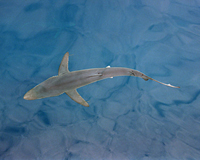 Once a subject shark of the proper specifications has been lured to the
boat
it is drawn close by using a fresh salmon or tuna head fascine with
monofilament line as bait. As the shark attempts to grab hold of the
bait it
can be brought right along side the boat where it can be scooped up in
a
long handled sport fishing net.
A practiced crew can scoop, land, sample/tag and release sharks up to
2 meters TL in less than 4 minutes.
Once a subject shark of the proper specifications has been lured to the
boat
it is drawn close by using a fresh salmon or tuna head fascine with
monofilament line as bait. As the shark attempts to grab hold of the
bait it
can be brought right along side the boat where it can be scooped up in
a
long handled sport fishing net.
A practiced crew can scoop, land, sample/tag and release sharks up to
2 meters TL in less than 4 minutes.

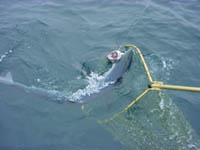
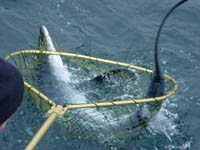
Once aboard, the subject animals are carefully removed from the
scoop-net
and restrained.
Once the sharks has been properly arrested and restrained it can be
quickly
measured for total length (TL), sampled for tissue or blood, tagged or
attached with a transmitter and then released. The procedure should
never
take longer than 4 minutes.
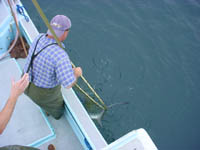
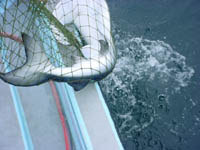
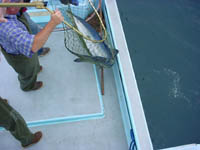
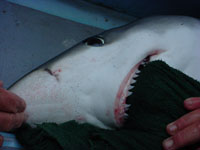
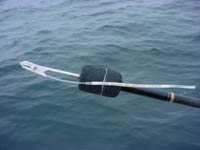
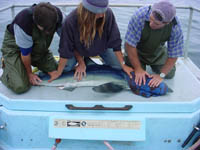
Things to consider:
Plan out each capture and intended arrest procedure and sample
assignment,
be organized.
Shade for the animal’s eyes on bright days will reduce unruly
behaviors,
alternately; the use of a ‘bit’ or something like a towel for the shark
to
bite on can assist in handling procedure, and this is often useful for
larger sharks. The scoop- net method should not be attempted with
animals
larger than the researchers involved.
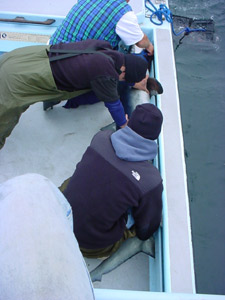
 The larger the shark the more likely it is inflict and/or sustain
damage due to capability to powerfully struggle.
While the fragility of sharks (while out of water) is overstated it is
very important that hard contacts and blows to the head, gills and body
cavity be minimized. A towel can be used to both shade the eyes, occupy the jaws
while serving as both a carry handle as well as a crash helmet for the
unruly shark. Upon allowing the shark to bite down on a wadded end of a
towel, the animal will often twist around and wrap its head in the
towel.
This wrapped towel can help put the business end of the shark out of
commission and provide a grab-hold.
The larger the shark the more likely it is inflict and/or sustain
damage due to capability to powerfully struggle.
While the fragility of sharks (while out of water) is overstated it is
very important that hard contacts and blows to the head, gills and body
cavity be minimized. A towel can be used to both shade the eyes, occupy the jaws
while serving as both a carry handle as well as a crash helmet for the
unruly shark. Upon allowing the shark to bite down on a wadded end of a
towel, the animal will often twist around and wrap its head in the
towel.
This wrapped towel can help put the business end of the shark out of
commission and provide a grab-hold.
This procedure greatly reduces stresses and injury compared with
conventional hook and line collecting.
Long-lining and sport angling can injure or impair the subject sharks;
all
things considered sharks are very resilient and can often weather very
rough
treatment at the hands of commercial and sport-fisherman or research
hook/line operators and some remarkable tag recoveries have been
gathered
using conventional methods. We are convinced that innovative PSRF
collecting
and sampling methods significantly exclude typical injuries associated
with
tag and release efforts.
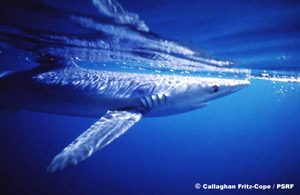
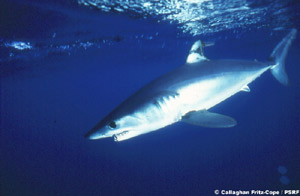
The PSRF open-water project has tallied over 1500 blue, Shortfin mako
and
common thresher sharks within the Monterey Bay since 1990; earlier
preliminary work was conducted over the Monterey Marine Canyon by Sean
Van
Sommeran beginning in 1989.
Sharks tagged within the Monterey Bay have been recovered from Dana
Point
California and the Channel Islands, off the coast of Baja Mexico. One
blue
shark tagged by PSRF staffers during the summer of 2000 was recovered
less
than 600 miles off the coast of Japan by a commercial long-lining
vessel.
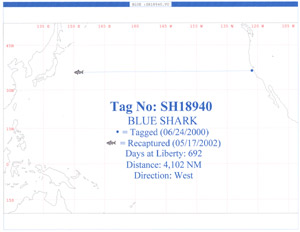
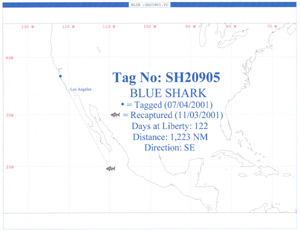
The very lucrative ‘shark-fin trade’ has virtually eliminated the
‘bycatch’
category for blue sharks as all sharks caught by the vast open sea
fleets are finned and killed off.
The ‘shark-fin trade’ is a very shady and under the table market with
well known but underplayed connections to organized crime that have actually
resulted in numerous armed robberies, heists, and shootings in Central
America, California, South Africa and elsewhere.
| 